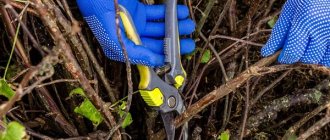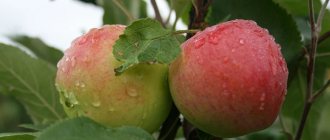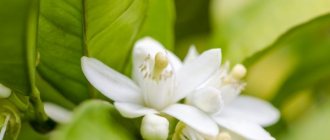4731
Chubushnik (garden jasmine) is an unpretentious frost-resistant plant suitable for cultivation in most regions of Russia. The most popular types are coronal, odorless, large-flowered, and small-leaved. Based on them, breeders developed various varieties: from dwarf varieties (Gnome, Dwarf, Yunnat) to tree-like varieties (Ballet of Moths, Airborne Assault, Snow Avalanche).
Blooming mock orange bush
Many gardeners mistakenly consider this shrub to be a variety of jasmine. However, the latter belongs to the Olive family, while mock orange is a representative of the Hydrangeaceae. For mock orange, planting and care are radically different from similar procedures for jasmine. In order to choose the right place for a shrub, plant it and draw up a schedule for seasonal work, you need to get to know the perennial better.
Planting and caring for mock orange
- Planting: from mid-September to mid-October, but if necessary, in the spring, before the buds swell.
- Flowering: from late May to late July.
- Lighting: bright sunlight
- Soil: permeable, light and fertile soil.
- Watering: once a week, using 2-3 buckets of water for each plant. During the flowering period, watering is carried out almost every day.
- Feeding: in the spring - a bucket of slurry (1:10) for each bush, after flowering, wood ash is scattered in the tree trunk circle, and then watered. Mineral fertilizers can be applied only from the fourth year of the mock orange’s life, and nitrogen fertilizers only in the spring.
- Pruning: in autumn – sanitary, in spring – sanitary and formative.
- Reproduction: seeds, cuttings, layering and dividing the bush.
- Pests: bean aphids, green leaf weevils, hawthorns, click beetles, spider mites.
- Diseases: gray rot, septoria.
Read more about growing mock orange below.
How to prune mock orange after flowering
How to prune mock orange after flowering photo
Even at the very beginning, before planting, it is necessary to inspect the bush and remove all branches that interfere with the formation of a beautiful crown. Leave branches with two or three healthy buds at the base of the bush. The rest must be removed.
Pruning mock orange after flowering photo
A year later, after the mock orange has faded, the bush is inspected. They do this in order to eliminate weak branches and those that have undergone a degenerative process. They are removed until growth begins. In the third year and subsequent years (after flowering), the branches are cut down to the part of the growth on which flowering was observed. If pruning rules are violated during sanitary pruning of the bush, up to 25% of dead and old branches are removed. Each subsequent year it will be easier to prune and shape the crown of the jasmine bush.
Trimming jasmine video:
Botanical description
Numerous stems of all shrubs of this genus are covered with thin gray bark. The bark of young shoots is mostly brown and peeling. The mock orange wood is hard and the core is wide. Simple leaves from 2 to 7 cm long, depending on the type, are elongated, ovate or broadly ovate. Typically, fragrant, simple, semi-double or double mock orange flowers, collected in racemes, are formed at the ends of young shoots. The mock orange fruit is a three- to five-sided capsule with small seeds.
Garden mock orange is winter-hardy, but each type of plant behaves differently depending on the climatic conditions of the area where it grows. However, even if the mock orange bush is severely damaged by frost in a harsh winter, only its above-ground part will die, and if you prune it in the spring, then, thanks to the powerful root system of the plant, the mock orange will very quickly grow back and restore its decorative appearance.
Why mock orange does not bloom Pests and diseases
Among the pests that can spoil the appearance of jasmine, the most common are spider mites, insects of the aphid family and leafy green weevil. You can get rid of them using insecticides. During spring and autumn treatment of the bush, it is best to use karbofos in accordance with the instructions.
Mock orange may not bloom for the following reasons:
Why garden jasmine mock orange does not bloom, what to do?
- The wrong place for the bush to grow is chosen. Shady places negatively affect the plant and it should be replanted.
- The soil does not meet the requirements, the land is severely depleted. You should dig up and transplant the jasmine bush into the soil necessary for its normal growth and flowering. Only fertile, breathable soil, with timely fertilizing with mineral components and organic matter will be suitable.
- Jasmine does not like severe waterlogging. In areas where it is too damp, it is not recommended to plant mock orange. Installing a good drainage system to drain water from the ground will be the ideal way out of this situation. Sometimes a thick layer of drainage 15-20 cm in a hole for planting a crop helps to cope with this problem.
- Feeding the bushes is not carried out according to the rules; excess nitrogen is introduced. If you follow all the requirements, the problem will disappear on its own.
- Both excessive watering and lack of moisture greatly affect the condition of the plant. During periods of drought, additional watering of the crop is organized, otherwise the plant not only will not bloom, but may also die.
- When planting or replanting a shrub to another place, make sure that the root collar is not buried more than 2 cm. Otherwise, it will support, which will lead to its rotting and, as a result, the growth of the plant will be inhibited.
Planting mock orange
When to plant
Mock orange is planted in open sunny areas, where it will bloom luxuriantly and smell fragrant. In the shade, the flowers of the shrub bloom small, and the shoots become too elongated. The optimal soil composition for mock orange is humus, sand and leaf soil in a ratio of 1:2:3, and if the soil on the site does not have good water permeability, then a drainage layer is added to the hole when planting.
- Lotus settled in the country house
It is better to plant mock orange in the fall, from mid-September to mid-October. You can plant mock orange in the spring, but planting mock orange in spring is complicated by the fact that you need to do it before the buds open on the trees.
How to plant
If you are planting several bushes, then dig holes at a distance of 50 to 150 cm, depending on how mature the plant will be. If you decide to plant a mock orange hedge, then the seedlings are planted at a distance of 50-70 cm from each other. A drainage layer of broken brick and sand 15 cm thick is poured into a hole measuring 60x60x60, then a layer of soil mixture, the composition of which is described in the previous section. It is advisable to do this a week or two before planting the mock orange.
When the soil settles, the root of the seedling is immersed in the hole so that its root collar is flush with the surface of the site, then the hole is filled with fertile soil. After planting, mock orange seedlings are moistened abundantly by pouring 2-3 buckets of water under each. When the soil settles after watering, add dry soil to the holes. It doesn’t matter if, after precipitation, the root collar sinks 3 cm into the soil, but this is the maximum safe depth - if the root collar is deeper, it may rot.
A day or two after planting, mulch the tree trunk circle with peat or sawdust with a layer of 3-4 cm.
Mock orange in landscape design
Landscape designers widely use shrubs in street design:
- create hedges;
- decorate alleys, parks, and recreation areas with shrubs;
- they make up whole compositions with both tall trees and flowering plants, for example, hydrangeas, roses;
- plant single plants in summer cottages, gardens, and near city benches;
- create entire “ensembles” with continuous flowering.
The perennial feels comfortable with all flowering shrub plants and woody trees. They plant it in flower beds and decorate lawns with it.
If you are into gardening, be sure to find a place for mock orange in your garden. This unpretentious representative of the flora will win your heart with its snow-white flowers, rich greenery, and floral and fruity aromas.
Caring for mock orange
Growing conditions
If the plant lacks moisture, its leaves will tell you about it. Mock oranges do not tolerate drought well, and in the hottest part of summer, their leaves lose turgor and droop without sufficient watering. It is recommended to water the mock orange weekly with two or three buckets of water, and during the flowering period, watering will have to be done almost daily. After moistening the soil in the area, you need to loosen the soil around the bushes and remove weeds. We remind you: if you mulched the area in the spring, then you will have to water, loosen and weed the soil much less often.
As for the mock orange’s nutrition, it responds best to the application of slurry (in a ratio of 1:10) - one bucket of this fertilizer is poured once a year under each adult mock orange bush, and it is advisable to do this in the spring. After flowering, mock orange is fertilized with wood ash, scattering it around the tree trunk before watering. From the fourth year of life, you can carry out spring fertilizing with complex mineral fertilizers at the rate of 30 g of superphosphate, 15 g of urea and the same amount of potassium sulfate per bucket of water, which should be enough for two adult bushes.
After flowering, 15 g of potassium sulfate and 25 g of superphosphate are added per 1 m² of area. Potassium can be replaced by scattering 100-150 g of wood ash under each bush. Nitrogen fertilizers are applied only in spring.
Trimming
If you want to see lush mock orange blossoms every year, you need to trim it regularly. The peculiarity of the plant is that only strong shoots from the previous year bloom profusely, and on thin and weak old branches, flowers, if they appear, are in much smaller quantities, and because of this the bush looks disheveled. Therefore, after the mock orange has faded, you need to prune the faded branches to this year’s strong shoots, which are located below.
Please note: over time, this year's young growths become more powerful, which means that next year you can expect abundant flowering from them.
Pruning mock orange in the fall also involves sanitary clearing of the bush: branches and shoots that thicken the crown are removed, as well as dry, painful or broken ones. Once every three years, remove shoots that are older than 12 years. Anti-aging pruning is done in early spring: several trunks are shortened to 30 cm, the rest are cut to soil level. The cuttings are treated with garden varnish, and the soil around the bush is mulched with peat. By autumn, strong young shoots will grow from dormant buds. But before you prune the mock orange, make sure that sap flow has not yet begun.
Transfer
Mock orange tolerates replanting easily, especially if you take this procedure responsibly, but you will have to sacrifice its lush crown and thereby lose a year of flowering. First you need to prepare a hole for the bush - two weeks before replanting, so that the earth settles. Then you need to abundantly water the bush that you are going to replant; after a day, remove half of the old shoots at the root, and shorten the rest. Now you can dig up the bush and move it to a new place, not forgetting to water it thoroughly after replanting.
The timing when mock orange can be replanted coincides with the timing of its primary planting - from mid-September to mid-October or in the spring, while the buds have not yet opened. However, replanting mock orange in the fall is much more convenient in the sense that you are not pressed for time, which means you can do this work more efficiently.
Pests and diseases
Among the few enemies of mock orange are bean aphids, spider mites and green leaf weevils. Aphids are destroyed by treating the bushes with Karbofos or Rogor in accordance with the instructions.
- Cletra: growing in open ground, types
In the fight against spider mites, products such as a three percent Keltan emulsion or a two percent Phosfamide solution, which are used to treat mock orange bushes two to three times at intervals of a week, have proven themselves well. And weevil larvae and beetles die from spraying with Chlorophos.
Mock orange in Siberia and the Moscow region
Readers often ask questions about which mock orange is more suitable for the Moscow region and whether this plant can be grown in Siberia. Mock orange is not a capricious plant at all, and it is also frost-resistant, so there are no big differences in the conditions for its cultivation in the southern regions or in the Moscow region. As for Siberia, there are winter-hardy varieties of mock orange with a viable root system that can withstand frosts down to -35 ºC without shelter! And if you consider that there is always a lot of snow in Siberia, you don’t have to worry about the wintering of less hardy species and varieties.
How to replant garden jasmine
In some cases, mock orange requires transplanting to a new location. This need arises for various reasons. For example, you need to make room for other crops, or initially the site was incorrectly selected for jasmine, where it does not develop actively enough. Perhaps the terrain has changed and the area has become flooded, or a building has appeared that blocks sunlight. There may be many reasons, however, an adult plant should not be replanted unless unnecessary. Often replanting is also required to plant a bush. At a young age, garden jasmine tolerates movement more easily, having natural strength for restoration and growth. A shrub older than 8 years may not take root at all.
Important! The main task of the gardener when replanting is to leave as many roots intact as possible, so it is not recommended to shake off the soil from them, especially not to wash them with water.
When to transplant mock orange
Most often, gardeners replant mock orange in the fall - in early or mid-October. It is unacceptable to replant the plant in the summer, especially during flowering. In some cases, changing the place of cultivation is carried out in the spring - at the end of March or beginning of April, before the buds open and the sap begins to flow. Spring transplantation is similar to autumn. However, here it should be understood that after this, garden jasmine will need quite a lot of time to restore strength and accumulate nutrients so that it can get stronger and take root.
How to transplant mock orange to a new place
The stages of work during transplantation of an adult mock orange bush are as follows:
- carry out pruning of excess, old, dry, weak branches and shoots that thicken the bush;
- using a rope, the branches of the bush are fastened together;
- water the bush generously with 5 - 6 liters of water to completely soften the soil;
- carefully dig around the jasmine tree trunk, retreating 30 cm from the trunk, removing the roots with an earthen lump without damaging them;
- pre-prepare a new planting hole, the size of which should be slightly larger than the size of the mock orange root system;
- at the bottom of the pit, place a layer of drainage and fertile soil with 2 handfuls of wood ash and the addition of superphosphate;
- the pit is watered with 1 bucket of water with a root-stimulating solution dissolved in it;
- install the replanted jasmine bush and sprinkle it with soil;
- the soil is compacted and shed abundantly;
- the tree trunk circle is mulched with pine needles, sawdust or fallen leaves;
- the ropes are removed from the jasmine branches.
Saplings, due to their young age, tolerate transplantation much easier. It is performed in the same way as for adult plants. Subsequent care for mock orange in the fall or spring is carried out according to the standard scheme.
Important! When replanting jasmine in spring, it is advisable to cut off all the branches, leaving only stumps up to 40 cm high. New branches will grow quickly, but you won’t have to count on flowering this year.
How to plant mock orange
The process of planting a mock orange bush is similar to transplanting. However, unlike this, such an event allows you to obtain new planting material. The duration of the procedure is the same as for transplantation. The dug up bush is carefully freed from excess soil, and the roots are washed if necessary. Using a sharp knife or pruning shears, divide them into several parts, making sure that each division leaves several strong growths with healthy buds. The ends of the branches and roots are trimmed a little. Planting of renewed seedlings is carried out similarly to the method described above with preliminary preparation of planting holes, drainage and fertile soil. The seedlings are buried to the top pair of buds, the soil is compacted and watered generously. When transplanting or planting garden jasmine, do not forget about mulching.
Only young jasmine shrubs are suitable for planting; old ones simply cannot cope with propagation in this way and will not take root in a new place. The resulting planting material is planted in accordance with all the requirements for growing mock orange. If during work individual roots are damaged, they must be removed and the cut treated with charcoal powder. Some time after transplantation, they begin to form a garden jasmine bush and give the crown a neat, symmetrical appearance.
Important! It is necessary to plant the dug out jasmine bushes immediately, preventing the root system from drying out.
Reproduction of mock orange
Reproduction methods
Planting and caring for mock orange is simple and easy, and methods for propagating garden jasmine will not seem complicated to you either. Mock orange reproduces generatively (by seeds) and vegetatively - by dividing the bush, cuttings and layering. And although propagation by seeds in the case of mock orange is much simpler than with other plants, varietal mock oranges are propagated vegetatively, since seedlings do not always inherit the characteristics of their parents.
Growing from seeds
Before sowing, mock orange seeds need two months of stratification at a temperature of 2-3 ºC. To do this, they are mixed with wet sand and peat in January, placed in a container and kept in the vegetable drawer of the refrigerator until spring.
In March, the seeds are sown in boxes filled with a soil mixture of leaf soil, humus and peat in a ratio of 1:1:2 with the addition of half a part of sand, sprinkled with sand on top and covered with glass. The soil is kept slightly moist, using a sprayer for watering - you will have to spray the crops two to three times a day. After a week or a week and a half, expect seedlings to emerge and, as soon as they develop several leaves, transplant the seedlings into open ground, providing them with protection from the sun for the first time.
Propagation by green cuttings
This method of propagation is the most reliable, since it gives 100% rooting. Cuttings are cut from developed large shoots, but for this purpose you should not take growth shoots with a wide hollow core and a large distance between the buds, since there is a high probability of putrefactive processes developing in these cavities.
The best planting material is green cuttings with a heel - annual shoots with part of last year's shoot. The cut of the cutting with the heel is treated with a root-forming preparation, planted in containers with a mixture of nutrient soil and sand to a depth of 0.5 cm according to the 40x10 pattern, covered with a plastic or glass cap to create greenhouse conditions and placed under diffused light. During rooting, cuttings need frequent spraying.
Reproduction by layering
Layerings of mock orange are easy to form, and their rooting rate is also very high – 50-70%. It is best to propagate mock orange by layering after anti-aging pruning, when the bush is cut at a height of 5-7 cm from the surface level. The soil around the bush is dug up, fertilized and leveled.
A young shoot is pulled with a soft wire near the lower bud, placed in a pre-dug groove 1.5 cm deep, secured and buried. In this way, you can take several shoots from one bush, arranging them radially, and by the end of the growing season you will have several plants with a powerful root system. The following spring they are separated from the mother plant, dug up and grown for another two years.
Dividing the bush
In the spring before the sap begins to flow or in the fall after the leaves fall, the overgrown mock orange is dug up, divided into several parts and quickly planted in new places so that the divisions do not have time to dry out. When dividing the bush, old branches that thicken the bush are removed, and young shoots are dug up.
Seedling preparation and planting work
Mock orange tolerates both primary and subsequent transplants well. Both young plants and mature trees take root in the new place. The optimal age for planting garden jasmines is from 2 to 3 years.
Before planting bushes in open ground, they are first prepared and trimmed. The root system is sprayed or sprinkled with root formation stimulants, and the crown is treated with a weak solution of manganese. The side shoots are cut off completely, and the top of the crown by a third. This procedure stimulates abundant tillering and rooting of mock orange.
The best time to transplant is early evening or morning. Frail seedlings, exposed to the scorching sun, wither and shed their leaves. Aggressive direct rays cause burns to leaves and buds. In this regard, it is recommended to shade the seedlings in the first week after planting.
Video with recommendations from an experienced gardener.
During transplantation, the bush is placed in the center and sprinkled with garden soil. It is recommended to plant shrubs at a distance of 1.5 m, dwarf varieties - 0.8 m. The plant does not need additional supports or mulching of the soil. The seedlings are shed generously with water as the hole dries out, but not more than once a day.
Types and varieties
Several species of mock orange and many varieties bred by breeders are grown in cultivation.
Common or pale mock orange (Philadelphus pallidus)
Originally from the south of Western Europe and the Caucasus. It is this species that is the first of the mock oranges to bloom in the Moscow region. The height of the common mock orange can reach 3 m, its shoots are erect and bare. Leaves up to 8 cm long are simple, oblong, elliptical, with sparse serrations along the edges and a pointed apex; the upper side of the leaf is bare, bright green, the lower side is pubescent, pale green. White-cream flowers up to 3 cm in diameter with a strong pleasant aroma are collected in 5-7 pieces in racemes.
- Whitewashing trees in spring: how and what to whitewash trees with
The species is winter-hardy and can withstand temperatures down to -25 ºC. It has several decorative forms: golden, large-flowered, terry, silver-edged, willow-leaved and low. Of the varieties more popular than others:
- Virgin mock orange is a variety created by Lemoine in 1909, 2 to 3 m high, with a wide crown, brown shoots and peeling bark. The leaves are up to 7 cm long, pointed, oval, dark green, yellow in autumn. It blooms in July with racemose inflorescences up to 14 cm long from white double flowers with a diameter of up to 5 cm. The decorative effect of this variety lasts up to 20 years;
- Mock orange Belle Etoile is the main achievement of Emile Lemoine as a breeder. In our conditions, a bush of this variety rarely grows above a meter, although in France it grows one and a half times higher. The leaves of this variety have a retracted tip and are small; flowers with a strawberry aroma, simple, bell-shaped, with a large carmine spot in the middle, reach a diameter of 4 cm;
- mock orange Bicolor - has single flowers crowning the lateral axillary shoot and reaching a diameter of 5 cm. The bush is fluffy, height - up to 2 m. This variety is often used in landscaping.
Crown mock orange (Philadelphus coronarius)
A southern European species up to 3 m high, found naturally in the Caucasus, Asia Minor and Southern Europe. It has yellowish or reddish-brown young shoots with cracked bark and dense foliage. The leaves are opposite, oval, with sparse teeth along the edges, petiolate, glabrous on the upper side, pubescent along the veins on the lower side. Fragrant creamy flowers up to 5 cm in diameter are collected in racemose terminal inflorescences of 5-7 pieces. This species blooms for up to three weeks.
Smoke-, gas-, cold-resistant - withstands frosts down to -25 ºC. The best varieties:
- Aureus is a fast-growing shrub 2-3 m high with a spherical crown of bright yellow leaves, which become yellow-green by summer and remain that way until the leaves fall. Numerous flowers against the background of leaves are almost indistinguishable, but the fact that the bush has bloomed can be determined even from afar by its amazing aroma. The value of the variety is represented by the mock orange leaf of unusual color and the strong aroma of its flowers;
- Variegatus, or Bowles Variety , is a shrub up to 3 m high with a creamy, wide, uneven stripe along the edges of the leaves;
- Innosense is a compact bush of medium size - no higher than 2 m - with single white simple flowers and a strong aroma. Leaves with uneven cream spots.
Lemoine mock orange (Philadelphus x lemoinei)
A hybrid between small-leaved mock orange and common mock orange. In culture, it is widespread in Europe and North America. This species reaches a height of 3 m, it has spreading branches with ovoid lanceolate leaves up to 4 cm long and large white fragrant flowers collected in brushes of 3-7 pieces. This hybrid has many varieties that have gained wide popularity among professionals and amateurs:
- Ermine Mantle (Manto d'Ermine) - a bush no higher than 1 m with graceful semi-double white flowers that bloom profusely for up to a month and a half;
- mock orange Schneersturm is a girlish mock orange with fragrant white flowers with a diameter of 2-2.5 cm, collected in racemes; The leaves are large, dark green, turning yellow in autumn. Bush up to 2 m high;
- Glacier - double mock orange with bunches of large fragrant white flowers that bloom for about three weeks; bush up to 2 m high;
- Charm is one of the most beautiful mock oranges: densely double large snow-white flowers, almost odorless, are collected in inflorescences of 9 or more pieces on a bush up to 2 m high. The disadvantage of this variety is that its lower part is exposed, so for To restore its decorative effect, professionals recommend planting low-growing shrubs in front of it;
- mock orange Snow Storm - bush up to 2 m high; double white flowers are collected in inflorescences of 7-9 pieces and bloom profusely for about three weeks.
In addition to the described species, Schrenk's, Gordon's, broad-leaved, thin-leaved, grayish, fluffy, odorless, small-leaved, large-flowered and Caucasian mock oranges are grown in culture.











